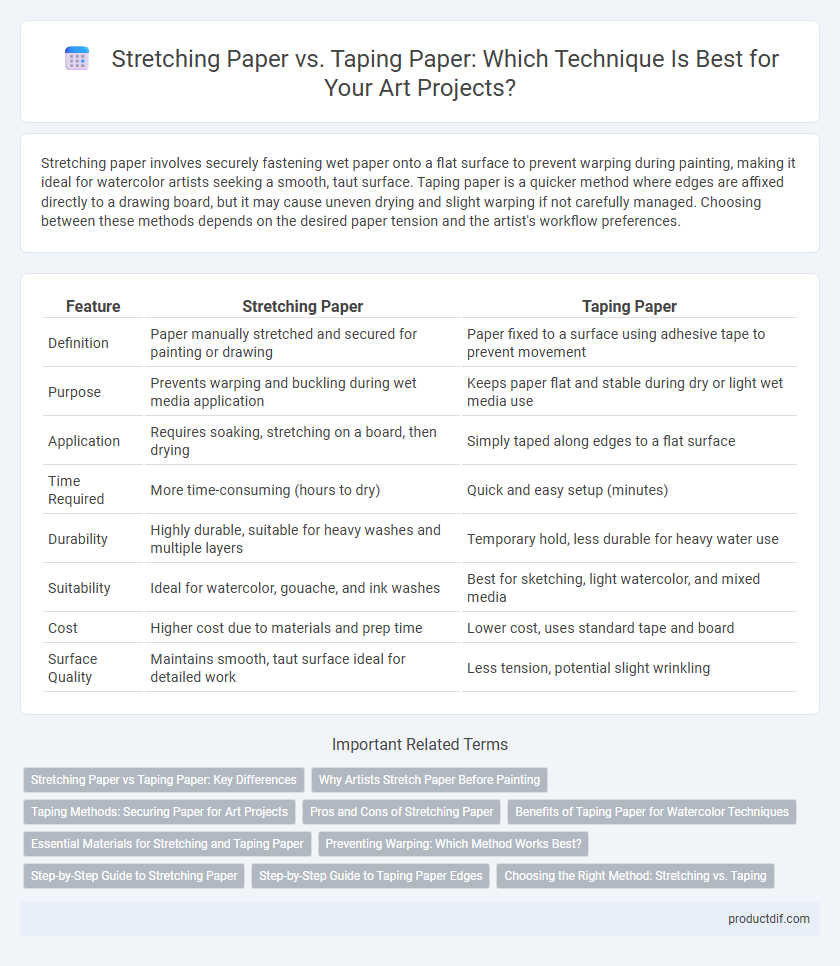Stretching paper involves securely fastening wet paper onto a flat surface to prevent warping during painting, making it ideal for watercolor artists seeking a smooth, taut surface. Taping paper is a quicker method where edges are affixed directly to a drawing board, but it may cause uneven drying and slight warping if not carefully managed. Choosing between these methods depends on the desired paper tension and the artist's workflow preferences.
Table of Comparison
| Feature | Stretching Paper | Taping Paper |
|---|---|---|
| Definition | Paper manually stretched and secured for painting or drawing | Paper fixed to a surface using adhesive tape to prevent movement |
| Purpose | Prevents warping and buckling during wet media application | Keeps paper flat and stable during dry or light wet media use |
| Application | Requires soaking, stretching on a board, then drying | Simply taped along edges to a flat surface |
| Time Required | More time-consuming (hours to dry) | Quick and easy setup (minutes) |
| Durability | Highly durable, suitable for heavy washes and multiple layers | Temporary hold, less durable for heavy water use |
| Suitability | Ideal for watercolor, gouache, and ink washes | Best for sketching, light watercolor, and mixed media |
| Cost | Higher cost due to materials and prep time | Lower cost, uses standard tape and board |
| Surface Quality | Maintains smooth, taut surface ideal for detailed work | Less tension, potential slight wrinkling |
Stretching Paper vs Taping Paper: Key Differences
Stretching paper involves soaking and securing the paper on a wooden frame to prevent warping during painting, making it ideal for watercolor artists seeking smooth, wrinkle-free surfaces. Taping paper uses adhesive tape to fix the edges directly to a board, offering a quicker but less durable solution that may cause uneven tension and potential paper damage. Stretching maintains consistent tension and better preserves the paper's texture, while taping prioritizes convenience over long-term stability.
Why Artists Stretch Paper Before Painting
Artists stretch paper before painting to prevent buckling and warping caused by water or wet media, ensuring a flat and stable surface. Stretching fibers tightens the paper, maintaining its integrity and improving paint application precision. This process enhances the longevity and appearance of the artwork by reducing distortion during drying.
Taping Methods: Securing Paper for Art Projects
Taping paper for art projects involves using archival artist tape or painter's tape to secure the edges of the paper onto a flat surface, preventing movement during painting or drawing. This method reduces warping and buckling, especially when working with watercolors, by maintaining tension without the need for soaking or stretching. Proper taping ensures clean borders and helps achieve crisp, professional results in various art mediums.
Pros and Cons of Stretching Paper
Stretching paper ensures a flat, stable surface by evenly tightening the fibers, preventing buckling during painting and allowing for smooth brushstrokes. However, it requires time, skill, and materials such as staples or gummed tape to secure the edges, and improper stretching can distort the paper or cause tearing. While it provides superior long-term stability, it may not be practical for quick projects or on delicate, thin papers prone to damage under tension.
Benefits of Taping Paper for Watercolor Techniques
Taping paper for watercolor techniques offers increased control and stability, preventing the paper from warping or buckling during the painting process. It ensures cleaner edges and sharper borders, enhancing the overall presentation of the artwork. Taped paper also facilitates easy removal after drying, reducing the risk of tears and preserving the integrity of delicate watercolor washes.
Essential Materials for Stretching and Taping Paper
Essential materials for stretching paper include a sturdy stretcher frame, fine-grit sandpaper for smoothing edges, and strong, non-acidic watercolor paper to prevent warping. For taping paper, high-quality acid-free artist's tape or masking tape and a clean, flat surface are vital to secure the paper without damaging its fibers. Both techniques require a clean water source and a sponge or brush to evenly dampen the paper, ensuring proper adhesion and tension.
Preventing Warping: Which Method Works Best?
Stretching paper involves wetting the paper and securing it tightly to a rigid surface, allowing it to dry flat and preventing warping effectively by maintaining tension. Taping paper relies on adhesive tape to hold the edges down, which can sometimes fail to prevent warping, especially with heavier water or paint applications. For artists seeking maximum flatness and durability during watercolor or ink work, stretching paper is generally the superior method to prevent warping.
Step-by-Step Guide to Stretching Paper
To stretch paper for art, begin by soaking the sheet in clean, cold water for 5-10 minutes to fully saturate the fibers. Remove excess water gently and pin or tape the wet paper onto a flat wooden board, ensuring the surface is smooth and taut. Allow the paper to dry completely, typically 24 hours, resulting in a wrinkle-free, stable surface ideal for watercolor or mixed media techniques.
Step-by-Step Guide to Taping Paper Edges
To tape paper edges effectively, start by securing the corners with small strips of acid-free artist's tape, ensuring the paper remains flat and taut. Next, apply the tape along each side, pressing firmly to prevent air bubbles and wrinkles while maintaining an even tension. This method prevents warping during painting, offering an affordable alternative to stretching without compromising the artwork's surface integrity.
Choosing the Right Method: Stretching vs. Taping
Choosing between stretching paper and taping paper depends on the type of artwork and paper quality. Stretching paper involves securing it on a rigid surface and tightening to prevent warping, ideal for watercolors and heavier papers. Taping paper offers a simpler, less permanent hold on lighter sheets but can cause edge damage or buckling during wet media application.
Stretching Paper vs Taping Paper Infographic

 productdif.com
productdif.com